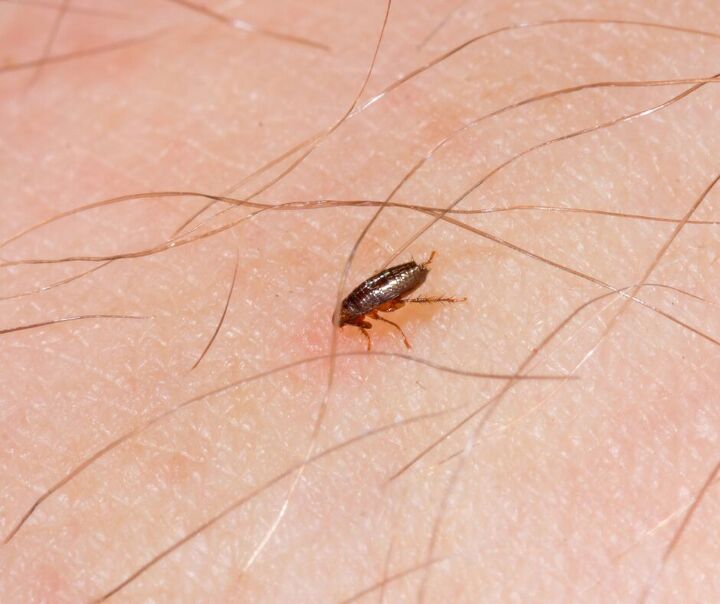What Are These Tiny Jumping Bugs In The Bathroom?

With every season comes its new challenges and new unwelcome house guests. In the summer, you may see tiny jumping bugs in your bathroom. These tiny bugs are called springtails, and they love to emerge all summer long.
Springtails are small insects often mislabeled as something else, but they’re different from many common bugs you see, like fleas. These tiny bugs tend to be in the bathroom and may come out of crevices like drains or other areas. Locating nests and keeping them out of your home is the way to avoid a small infestation of springtails.
The peak of summer is the most common time to see many small bugs come out. Since the warmer weather and rainy days are the perfect conditions for mating, bug populations grow rapidly. Springtails are no different, and this is why you may find them in and around your home.
What Are These Tiny Jumping Bugs in the Bathroom?
As stated previously, the small black bugs you may see jumping in your bathroom are called springtails. They are commonly outdoor bugs that love to live on and in organic material, mainly found in gardens or mulch. You will find them under decaying logs and possibly rocks to avoid sunlight.
They are drilling-type bugs; they love to get down and dirty as they drill through the soil. This means they will not harm your big or full-grown plants but may damage seedlings. Their diet consists of mold, decaying plants, and fungus, which means they are good for the soil.
Springtails are known to be good jumpers because of their furcula, which are attached to the springtails’ abdomen. Springtails use the furcula to hoist themselves up to a distance of 4 inches. Because springtails are tiny and jump, you may confuse them with fleas.
Are Springtails the Same as Fleas?
No, springtails are not the same as fleas; they just have similar abilities. Springtails can jump or leap a great distance using the furcula. Their small, round bodies can confuse people into thinking these small bugs are fleas, but they are harmless to humans, unlike fleas.
On top of them being harmless, you may find that springtails are actually easier to kill. While fleas have a hard shell that can be hard to crush, springtails do not, and you can squish them effortlessly. This makes for an easy test to see if you have fleas or springtails in your home.
Like fleas, springtails are a bit hard to see with your naked eye, but it’s not impossible. They are only about ⅛ inch long, full-grown, and, like fleas, they can hide in various crevices. But it is important to know what type of insect you may be dealing with; springtails are a high probability.
Do Springtails Bite Humans?
A simple answer to this question is no, and just because they look like fleas does not mean they bite. Springtails are insects that prefer the woods and decaying leaves over human flesh. They are harmless to humans and are even harmless to your pets since they prefer dirt.
However, they can still be a nuisance to humans. Since they are small and tough to detect, they have the advantage of populating quickly and causing an infestation. Cleaning and dehumidifying any room and all rooms can be key to drawing them out of your home.
Why Are Springtails in My Bathroom?
It is common that when the temperature changes, you may find critters and unwanted guests in your home. But why exactly are these tiny jumping bugs in the bathroom?
Springtails do not like the cold, and your home provides them with a temperature-controlled atmosphere. Plus, they love the damp air or floor of a bathroom.
Since springtails are tiny, simply slipping through cracks is their specialty, and cracks are not hard to find. They might even slip through a hole in the wall or a cracked window. They are drawn in by the possibility of a warm, damp place to hide out.
If your bathroom has a leak under the floor or sink or has high humidity, as they often do, springtails love it. The water creates mold and fungus for springtails to feed on, giving them every reason to stay. You may also want to check drains since they have been known to reside in such damp, dark spaces.
Do Springtails Come Out of Drains?
If you see springtails coming out of your drain, that can mean a few things. If you have a draining problem or a clog, springtails are often present and are a sign. They love all the fungus that grows in the drains and have no means to leave.
Typically, springtails are often associated with or found in sinks because they will go down drains for moisture. It could mean you have a moisture problem or a crack in a pipe somewhere. Springtails breed within walls and between concrete or tiny spaces and may have an access hole through your sink drain.
What If I See Springtails in My Bedroom or Other Areas?
Springtails are often associated with moisture; bathrooms are their common location. But if you find that springtails are in other areas of your home, look under the surface. You may be having moisture problems associated with your walls or floors.
You may want to look at where the springtails are or even deeper into your home. Do pipes run through this area, or is there a possible leak or crawlspace/basement problem? These are questions that may help to investigate why springtails are appearing in unconventional areas.
Another reason may just be that they are attracted to the lighting in your bedroom. Like many bugs, springtails are also attracted to light and warmth, so your bedroom may be just right. They might have even come through a simple window crack that may leak when it rains.
If your bedroom is attached to a bathroom, it is also quite possible that they might have just slipped in. Since the bathroom and moisture are close by, they may migrate or venture out of the comfort of your bathroom.
How Do I Get Rid of Springtails in My Bathroom?
There are a few things you can do once you know you have springtails. Cleaning is always the key to cleaning up water and dirt that may feed springtails. You can suck them out of your bathroom with something as simple as a vacuum, which is often effective.
Unclogging drains and mopping will help with the simple things. You may need to have your pipes or drains examined and fixed if a leak is suspected. By cutting off the springtails’ food and water source, they may vacate the area to find someplace else.
On top of cleaning and checking for leaks, dehumidifying the bathroom is essential. Again, removing the moist or damp air will take away their primary source of comfort. However, springtails cannot be killed off easily if an infestation has already occurred.
Calling for a professional pest controller never hurts if you believe you have a real problem. Springtails are masters at hiding in corners and small crevices and will show up weeks later.
Tips for Keeping Springtails Out of Your Home
To keep springtails out of your home, check for any gaps and cracks on your home’s walls. Along with your walls, you will want to check the window sills and door frames. You can fix this with a good quality caulk to seal up any and all holes you may find.
Check for water leaks around your foundation because a wet and damp foundation increases the humidity in your home. This not only attracts springtails but all kinds of insects like earwigs, centipedes, and cockroaches. If there are any water leaks, you will need to have your foundation repaired.
Lastly, look outside around the perimeter of your home. If there are shrubs or bushes close to your house, springtails can use them to get inside your home. So, it is best if there’s no vegetation and mulch along the outer walls.
And lastly, dehumidifiers keep the moisture content indoors low, which stops the springtails from entering your home.
How Can You Locate a Springtail Nest?
The scary thing is, there isn’t really a nest for you to find. Springtails will be scattered all about in any dark, damp area. They love nutrient-rich soils and mulch and may disperse their eggs in numerous locations.
You may find a colony, but it is likely a group of adults migrating to the same food source. They move to where it is best to find food and water. You may also see a lot of springtails if the soil is very wet — they surface to avoid drowning.
Springtails can have their burrows and eggs deep in the dirt. They are not very fast and will avoid going too far from their home. That is where their ‘nest’ is, but you may never find it.
A Final Look at Tiny Jumping Bugs in the Bathroom
Springtails are tiny insects that people often mistake for similar bugs they may resemble, especially fleas. But they are very different from many common bugs you see in your home. These little bugs have the ability to jump, but they do not bite humans or pets.
They tend to be in bathrooms and may come out of crevices like drains or cracks. They can be a bit of a pest if they infest your bathroom but cleaning, vacuuming, and dehumidifying can help. You can also prevent them from getting into your home by checking for cracks and leaks and moving bushes.
Locating nests and keeping them out of your home is the way to avoid a small infestation of springtails. Looking for a nest may be more difficult than you think, so try to protect your home first. Calling a professional may be necessary if an infestation occurs again or is too much to handle.

Stacy Randall is a wife, mother, and freelance writer from NOLA that has always had a love for DIY projects, home organization, and making spaces beautiful. Together with her husband, she has been spending the last several years lovingly renovating her grandparent's former home, making it their own and learning a lot about life along the way.
More by Stacy Randall

















![Best Farmhouse Bathroom Vanities [Rustic & For Small Bathrooms]](https://cdn-fastly.upgradedhome.com/media/2023/07/31/9074467/best-farmhouse-bathroom-vanities-rustic-for-small-bathrooms.jpg?size=350x220)









![Standard Dining Room Table Dimensions [for 4, 6, 8, 10 and 12 People]](https://cdn-fastly.upgradedhome.com/media/2023/07/31/9074335/standard-dining-room-table-dimensions-for-4-6-8-10-and-12-people.jpg?size=350x220)


